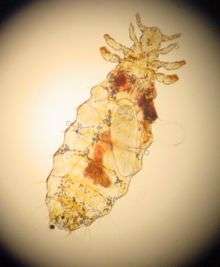Sucking louse
Sucking lice (Anoplura, formerly known as Siphunculata) have around 500 species and represent the smaller of the two traditional suborders of lice. As opposed to the paraphyletic chewing lice, which are now divided among three suborders, the sucking lice are monophyletic.
| Sucking louse | |
|---|---|
 | |
| Linognathus setosus (Linognathidae) | |
| Scientific classification | |
| Kingdom: | Animalia |
| Phylum: | Arthropoda |
| Class: | Insecta |
| Order: | Phthiraptera |
| Suborder: | Anoplura Leach, 1815 |
| Diversity | |
| 15 families | |
| Synonyms | |
|
Siphunculata | |
The Anoplura are all blood-feeding ectoparasites of mammals. They only occur on about 20% of all placentalian mammal species, and are unknown from several orders of mammals (Monotremata, Edentata, Pholidota, Chiroptera, Cetacea, Sirenia and Proboscidea).[1] They can cause localized skin irritations and are vectors of several blood-borne diseases. Children appear particularly susceptible to attracting lice, possibly due to their fine hair.
At least three species or subspecies of Anoplura are parasites of humans; the human condition of being infested with sucking lice is called pediculosis. Pediculus humanus is divided into two subspecies, Pediculus humanus humanus, or the body louse, sometimes nicknamed "the seam squirrel" for its habit of laying of eggs in the seams of clothing, and Pediculus humanus capitis, or the head louse. Pthirus pubis (the crab louse) is the cause of the condition known as crabs.
Families
These 15 families are generally recognized in the Anoplura:
- Echinophthiriidae – seal lice
- Enderleinellidae
- Haematopinidae – ungulate lice
- Hamophthiriidae
- Hoplopleuridae – armoured lice
- Hybophthiridae
- Linognathidae – pale lice
- Microthoraciidae
- Neolinognathidae
- Pecaroecidae
- Pedicinidae – Old World monkey lice
- Pediculidae – body lice
- Pthiridae – pubic lice
- Polyplacidae – spiny rat lice
- Ratemiidae
See also
- Use of DNA in forensic entomology
References
- Piotrowski, F. (1992): Anoplura (echte Läuse). de Gruiter; 61 pp. (page 8)
External links
| Wikimedia Commons has media related to Anoplura. |
| Wikispecies has information related to Anoplura |
- Solenopotes capillatus, little blue cattle louse on the UF / IFAS Featured Creatures Web site
- VectorBase homepage for Pediculus humanus (genome browser, downloads and more)